Impact of Media on Scientific Perceptions and Stereotypes: An Analysis
VerifiedAdded on 2023/03/17
|8
|2352
|24
Essay
AI Summary
This essay delves into the significant role of media in shaping public perceptions and stereotypes of scientists, tracing the evolution from traditional portrayals to modern representations. It explores how early media, such as cartoons and movies like Frankenstein, fostered negative stereotypes of scientists as eccentric or even evil, often isolating them from mainstream society. The essay contrasts these historical depictions with the more positive influence of modern media, particularly crime dramas like CSI, which showcase scientists' contributions to society and help to neutralize negative stereotypes. Furthermore, it examines the impact of information technology and mass media on the spread of these perceptions. The conclusion highlights the media's responsibility in presenting a balanced view of scientists, acknowledging both their achievements and potential flaws, and calls for a more nuanced understanding of their profession.
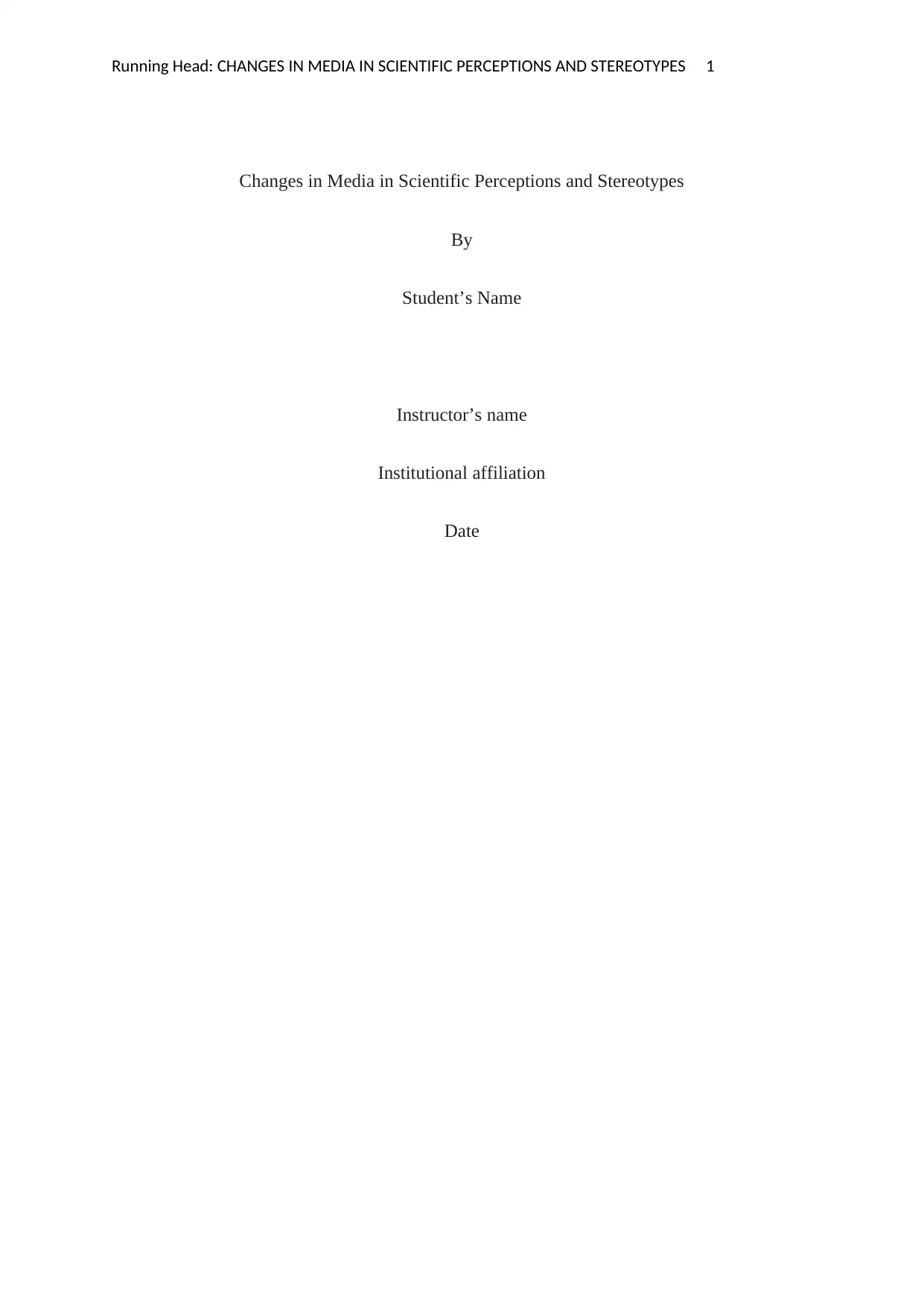
Running Head: CHANGES IN MEDIA IN SCIENTIFIC PERCEPTIONS AND STEREOTYPES 1
Changes in Media in Scientific Perceptions and Stereotypes
By
Student’s Name
Instructor’s name
Institutional affiliation
Date
Changes in Media in Scientific Perceptions and Stereotypes
By
Student’s Name
Instructor’s name
Institutional affiliation
Date
Paraphrase This Document
Need a fresh take? Get an instant paraphrase of this document with our AI Paraphraser
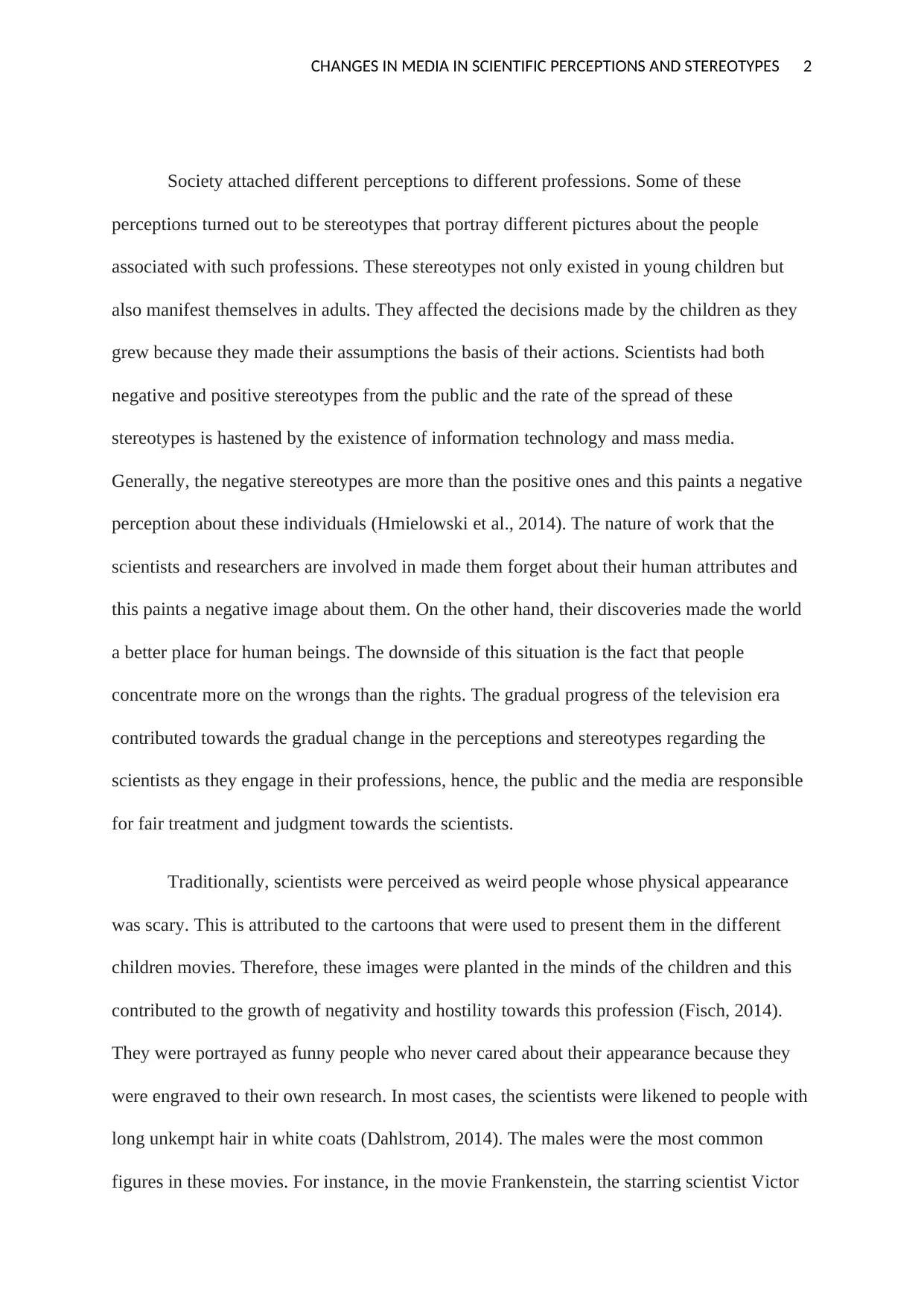
CHANGES IN MEDIA IN SCIENTIFIC PERCEPTIONS AND STEREOTYPES 2
Society attached different perceptions to different professions. Some of these
perceptions turned out to be stereotypes that portray different pictures about the people
associated with such professions. These stereotypes not only existed in young children but
also manifest themselves in adults. They affected the decisions made by the children as they
grew because they made their assumptions the basis of their actions. Scientists had both
negative and positive stereotypes from the public and the rate of the spread of these
stereotypes is hastened by the existence of information technology and mass media.
Generally, the negative stereotypes are more than the positive ones and this paints a negative
perception about these individuals (Hmielowski et al., 2014). The nature of work that the
scientists and researchers are involved in made them forget about their human attributes and
this paints a negative image about them. On the other hand, their discoveries made the world
a better place for human beings. The downside of this situation is the fact that people
concentrate more on the wrongs than the rights. The gradual progress of the television era
contributed towards the gradual change in the perceptions and stereotypes regarding the
scientists as they engage in their professions, hence, the public and the media are responsible
for fair treatment and judgment towards the scientists.
Traditionally, scientists were perceived as weird people whose physical appearance
was scary. This is attributed to the cartoons that were used to present them in the different
children movies. Therefore, these images were planted in the minds of the children and this
contributed to the growth of negativity and hostility towards this profession (Fisch, 2014).
They were portrayed as funny people who never cared about their appearance because they
were engraved to their own research. In most cases, the scientists were likened to people with
long unkempt hair in white coats (Dahlstrom, 2014). The males were the most common
figures in these movies. For instance, in the movie Frankenstein, the starring scientist Victor
Society attached different perceptions to different professions. Some of these
perceptions turned out to be stereotypes that portray different pictures about the people
associated with such professions. These stereotypes not only existed in young children but
also manifest themselves in adults. They affected the decisions made by the children as they
grew because they made their assumptions the basis of their actions. Scientists had both
negative and positive stereotypes from the public and the rate of the spread of these
stereotypes is hastened by the existence of information technology and mass media.
Generally, the negative stereotypes are more than the positive ones and this paints a negative
perception about these individuals (Hmielowski et al., 2014). The nature of work that the
scientists and researchers are involved in made them forget about their human attributes and
this paints a negative image about them. On the other hand, their discoveries made the world
a better place for human beings. The downside of this situation is the fact that people
concentrate more on the wrongs than the rights. The gradual progress of the television era
contributed towards the gradual change in the perceptions and stereotypes regarding the
scientists as they engage in their professions, hence, the public and the media are responsible
for fair treatment and judgment towards the scientists.
Traditionally, scientists were perceived as weird people whose physical appearance
was scary. This is attributed to the cartoons that were used to present them in the different
children movies. Therefore, these images were planted in the minds of the children and this
contributed to the growth of negativity and hostility towards this profession (Fisch, 2014).
They were portrayed as funny people who never cared about their appearance because they
were engraved to their own research. In most cases, the scientists were likened to people with
long unkempt hair in white coats (Dahlstrom, 2014). The males were the most common
figures in these movies. For instance, in the movie Frankenstein, the starring scientist Victor
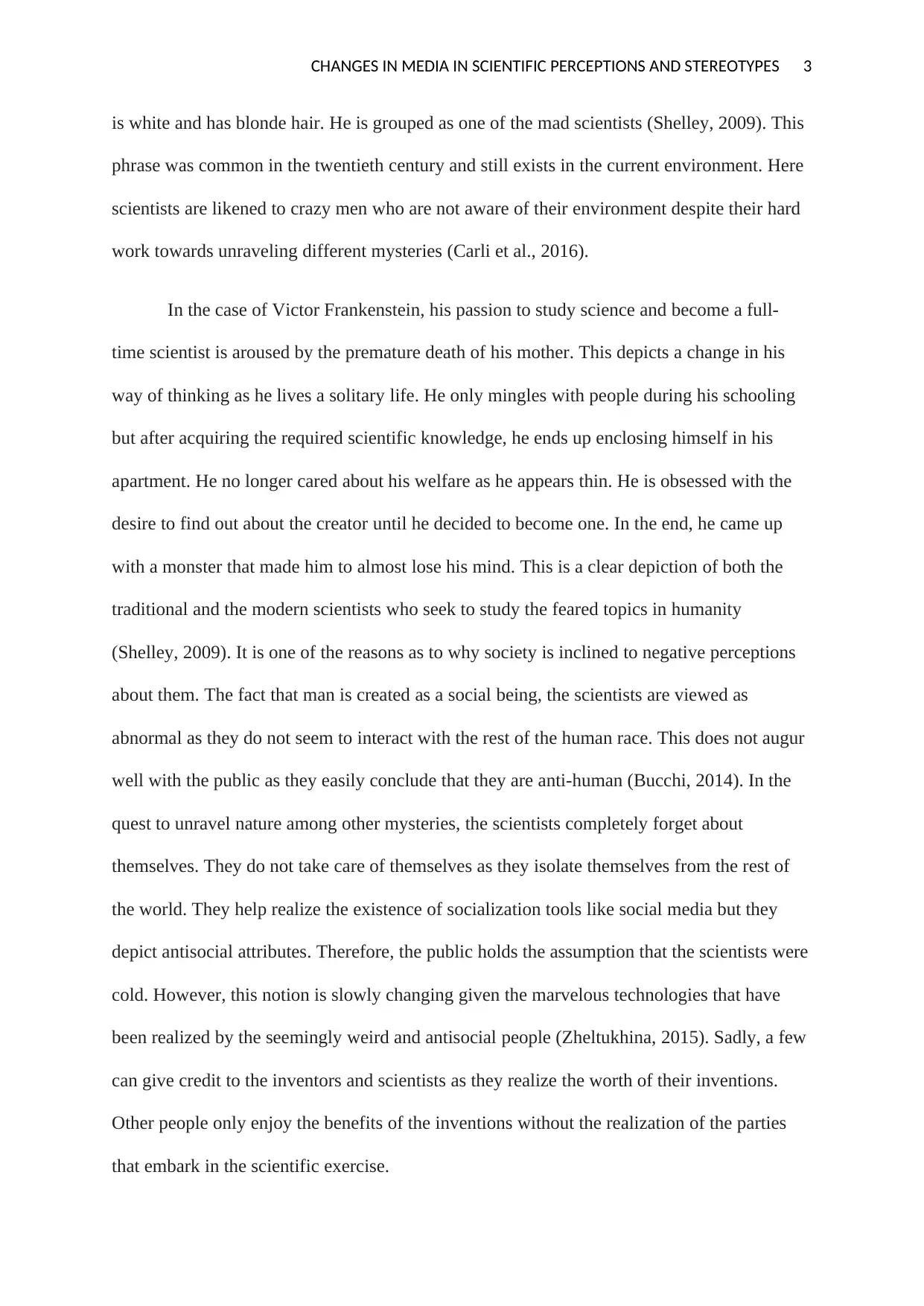
CHANGES IN MEDIA IN SCIENTIFIC PERCEPTIONS AND STEREOTYPES 3
is white and has blonde hair. He is grouped as one of the mad scientists (Shelley, 2009). This
phrase was common in the twentieth century and still exists in the current environment. Here
scientists are likened to crazy men who are not aware of their environment despite their hard
work towards unraveling different mysteries (Carli et al., 2016).
In the case of Victor Frankenstein, his passion to study science and become a full-
time scientist is aroused by the premature death of his mother. This depicts a change in his
way of thinking as he lives a solitary life. He only mingles with people during his schooling
but after acquiring the required scientific knowledge, he ends up enclosing himself in his
apartment. He no longer cared about his welfare as he appears thin. He is obsessed with the
desire to find out about the creator until he decided to become one. In the end, he came up
with a monster that made him to almost lose his mind. This is a clear depiction of both the
traditional and the modern scientists who seek to study the feared topics in humanity
(Shelley, 2009). It is one of the reasons as to why society is inclined to negative perceptions
about them. The fact that man is created as a social being, the scientists are viewed as
abnormal as they do not seem to interact with the rest of the human race. This does not augur
well with the public as they easily conclude that they are anti-human (Bucchi, 2014). In the
quest to unravel nature among other mysteries, the scientists completely forget about
themselves. They do not take care of themselves as they isolate themselves from the rest of
the world. They help realize the existence of socialization tools like social media but they
depict antisocial attributes. Therefore, the public holds the assumption that the scientists were
cold. However, this notion is slowly changing given the marvelous technologies that have
been realized by the seemingly weird and antisocial people (Zheltukhina, 2015). Sadly, a few
can give credit to the inventors and scientists as they realize the worth of their inventions.
Other people only enjoy the benefits of the inventions without the realization of the parties
that embark in the scientific exercise.
is white and has blonde hair. He is grouped as one of the mad scientists (Shelley, 2009). This
phrase was common in the twentieth century and still exists in the current environment. Here
scientists are likened to crazy men who are not aware of their environment despite their hard
work towards unraveling different mysteries (Carli et al., 2016).
In the case of Victor Frankenstein, his passion to study science and become a full-
time scientist is aroused by the premature death of his mother. This depicts a change in his
way of thinking as he lives a solitary life. He only mingles with people during his schooling
but after acquiring the required scientific knowledge, he ends up enclosing himself in his
apartment. He no longer cared about his welfare as he appears thin. He is obsessed with the
desire to find out about the creator until he decided to become one. In the end, he came up
with a monster that made him to almost lose his mind. This is a clear depiction of both the
traditional and the modern scientists who seek to study the feared topics in humanity
(Shelley, 2009). It is one of the reasons as to why society is inclined to negative perceptions
about them. The fact that man is created as a social being, the scientists are viewed as
abnormal as they do not seem to interact with the rest of the human race. This does not augur
well with the public as they easily conclude that they are anti-human (Bucchi, 2014). In the
quest to unravel nature among other mysteries, the scientists completely forget about
themselves. They do not take care of themselves as they isolate themselves from the rest of
the world. They help realize the existence of socialization tools like social media but they
depict antisocial attributes. Therefore, the public holds the assumption that the scientists were
cold. However, this notion is slowly changing given the marvelous technologies that have
been realized by the seemingly weird and antisocial people (Zheltukhina, 2015). Sadly, a few
can give credit to the inventors and scientists as they realize the worth of their inventions.
Other people only enjoy the benefits of the inventions without the realization of the parties
that embark in the scientific exercise.
⊘ This is a preview!⊘
Do you want full access?
Subscribe today to unlock all pages.

Trusted by 1+ million students worldwide
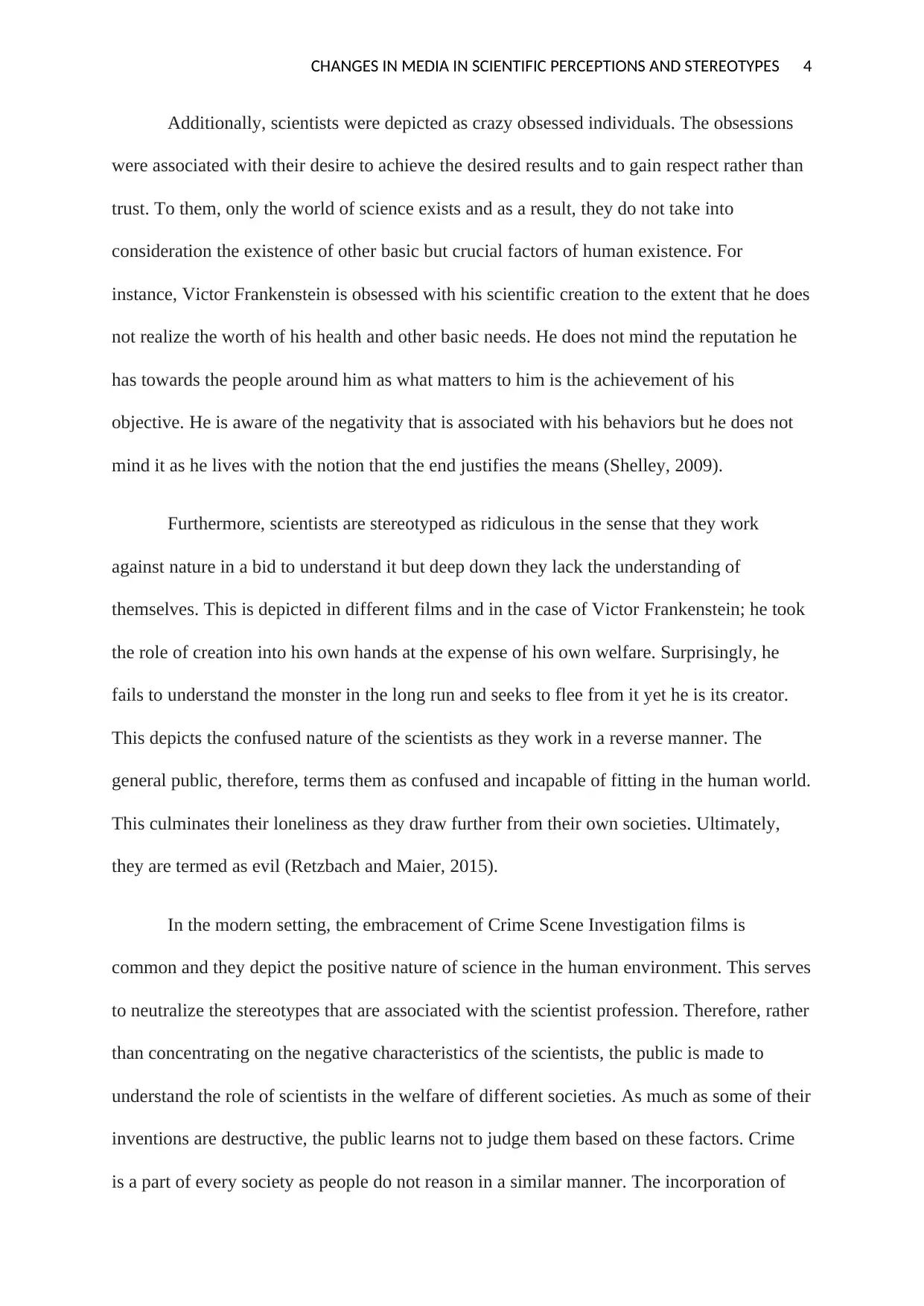
CHANGES IN MEDIA IN SCIENTIFIC PERCEPTIONS AND STEREOTYPES 4
Additionally, scientists were depicted as crazy obsessed individuals. The obsessions
were associated with their desire to achieve the desired results and to gain respect rather than
trust. To them, only the world of science exists and as a result, they do not take into
consideration the existence of other basic but crucial factors of human existence. For
instance, Victor Frankenstein is obsessed with his scientific creation to the extent that he does
not realize the worth of his health and other basic needs. He does not mind the reputation he
has towards the people around him as what matters to him is the achievement of his
objective. He is aware of the negativity that is associated with his behaviors but he does not
mind it as he lives with the notion that the end justifies the means (Shelley, 2009).
Furthermore, scientists are stereotyped as ridiculous in the sense that they work
against nature in a bid to understand it but deep down they lack the understanding of
themselves. This is depicted in different films and in the case of Victor Frankenstein; he took
the role of creation into his own hands at the expense of his own welfare. Surprisingly, he
fails to understand the monster in the long run and seeks to flee from it yet he is its creator.
This depicts the confused nature of the scientists as they work in a reverse manner. The
general public, therefore, terms them as confused and incapable of fitting in the human world.
This culminates their loneliness as they draw further from their own societies. Ultimately,
they are termed as evil (Retzbach and Maier, 2015).
In the modern setting, the embracement of Crime Scene Investigation films is
common and they depict the positive nature of science in the human environment. This serves
to neutralize the stereotypes that are associated with the scientist profession. Therefore, rather
than concentrating on the negative characteristics of the scientists, the public is made to
understand the role of scientists in the welfare of different societies. As much as some of their
inventions are destructive, the public learns not to judge them based on these factors. Crime
is a part of every society as people do not reason in a similar manner. The incorporation of
Additionally, scientists were depicted as crazy obsessed individuals. The obsessions
were associated with their desire to achieve the desired results and to gain respect rather than
trust. To them, only the world of science exists and as a result, they do not take into
consideration the existence of other basic but crucial factors of human existence. For
instance, Victor Frankenstein is obsessed with his scientific creation to the extent that he does
not realize the worth of his health and other basic needs. He does not mind the reputation he
has towards the people around him as what matters to him is the achievement of his
objective. He is aware of the negativity that is associated with his behaviors but he does not
mind it as he lives with the notion that the end justifies the means (Shelley, 2009).
Furthermore, scientists are stereotyped as ridiculous in the sense that they work
against nature in a bid to understand it but deep down they lack the understanding of
themselves. This is depicted in different films and in the case of Victor Frankenstein; he took
the role of creation into his own hands at the expense of his own welfare. Surprisingly, he
fails to understand the monster in the long run and seeks to flee from it yet he is its creator.
This depicts the confused nature of the scientists as they work in a reverse manner. The
general public, therefore, terms them as confused and incapable of fitting in the human world.
This culminates their loneliness as they draw further from their own societies. Ultimately,
they are termed as evil (Retzbach and Maier, 2015).
In the modern setting, the embracement of Crime Scene Investigation films is
common and they depict the positive nature of science in the human environment. This serves
to neutralize the stereotypes that are associated with the scientist profession. Therefore, rather
than concentrating on the negative characteristics of the scientists, the public is made to
understand the role of scientists in the welfare of different societies. As much as some of their
inventions are destructive, the public learns not to judge them based on these factors. Crime
is a part of every society as people do not reason in a similar manner. The incorporation of
Paraphrase This Document
Need a fresh take? Get an instant paraphrase of this document with our AI Paraphraser
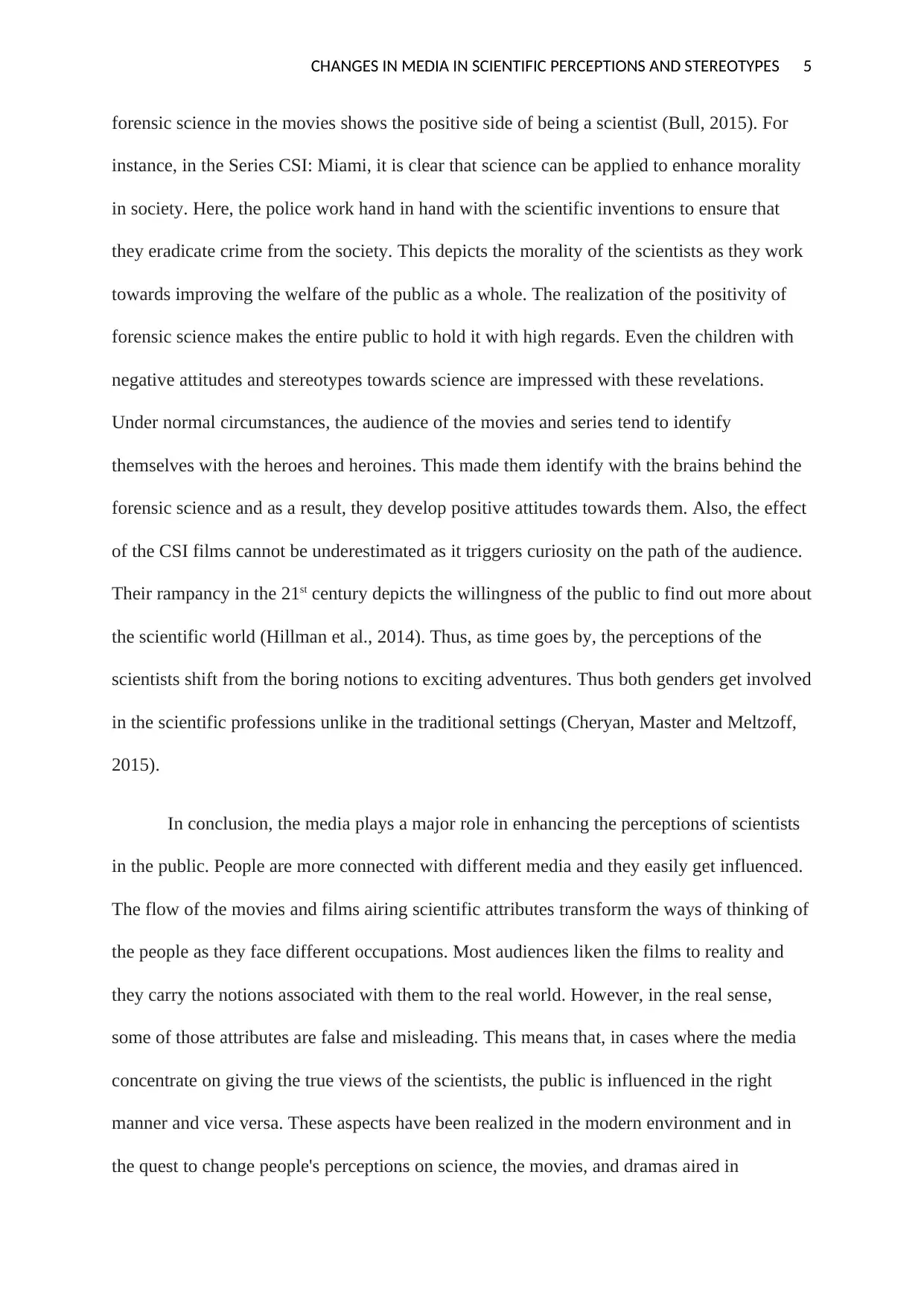
CHANGES IN MEDIA IN SCIENTIFIC PERCEPTIONS AND STEREOTYPES 5
forensic science in the movies shows the positive side of being a scientist (Bull, 2015). For
instance, in the Series CSI: Miami, it is clear that science can be applied to enhance morality
in society. Here, the police work hand in hand with the scientific inventions to ensure that
they eradicate crime from the society. This depicts the morality of the scientists as they work
towards improving the welfare of the public as a whole. The realization of the positivity of
forensic science makes the entire public to hold it with high regards. Even the children with
negative attitudes and stereotypes towards science are impressed with these revelations.
Under normal circumstances, the audience of the movies and series tend to identify
themselves with the heroes and heroines. This made them identify with the brains behind the
forensic science and as a result, they develop positive attitudes towards them. Also, the effect
of the CSI films cannot be underestimated as it triggers curiosity on the path of the audience.
Their rampancy in the 21st century depicts the willingness of the public to find out more about
the scientific world (Hillman et al., 2014). Thus, as time goes by, the perceptions of the
scientists shift from the boring notions to exciting adventures. Thus both genders get involved
in the scientific professions unlike in the traditional settings (Cheryan, Master and Meltzoff,
2015).
In conclusion, the media plays a major role in enhancing the perceptions of scientists
in the public. People are more connected with different media and they easily get influenced.
The flow of the movies and films airing scientific attributes transform the ways of thinking of
the people as they face different occupations. Most audiences liken the films to reality and
they carry the notions associated with them to the real world. However, in the real sense,
some of those attributes are false and misleading. This means that, in cases where the media
concentrate on giving the true views of the scientists, the public is influenced in the right
manner and vice versa. These aspects have been realized in the modern environment and in
the quest to change people's perceptions on science, the movies, and dramas aired in
forensic science in the movies shows the positive side of being a scientist (Bull, 2015). For
instance, in the Series CSI: Miami, it is clear that science can be applied to enhance morality
in society. Here, the police work hand in hand with the scientific inventions to ensure that
they eradicate crime from the society. This depicts the morality of the scientists as they work
towards improving the welfare of the public as a whole. The realization of the positivity of
forensic science makes the entire public to hold it with high regards. Even the children with
negative attitudes and stereotypes towards science are impressed with these revelations.
Under normal circumstances, the audience of the movies and series tend to identify
themselves with the heroes and heroines. This made them identify with the brains behind the
forensic science and as a result, they develop positive attitudes towards them. Also, the effect
of the CSI films cannot be underestimated as it triggers curiosity on the path of the audience.
Their rampancy in the 21st century depicts the willingness of the public to find out more about
the scientific world (Hillman et al., 2014). Thus, as time goes by, the perceptions of the
scientists shift from the boring notions to exciting adventures. Thus both genders get involved
in the scientific professions unlike in the traditional settings (Cheryan, Master and Meltzoff,
2015).
In conclusion, the media plays a major role in enhancing the perceptions of scientists
in the public. People are more connected with different media and they easily get influenced.
The flow of the movies and films airing scientific attributes transform the ways of thinking of
the people as they face different occupations. Most audiences liken the films to reality and
they carry the notions associated with them to the real world. However, in the real sense,
some of those attributes are false and misleading. This means that, in cases where the media
concentrate on giving the true views of the scientists, the public is influenced in the right
manner and vice versa. These aspects have been realized in the modern environment and in
the quest to change people's perceptions on science, the movies, and dramas aired in
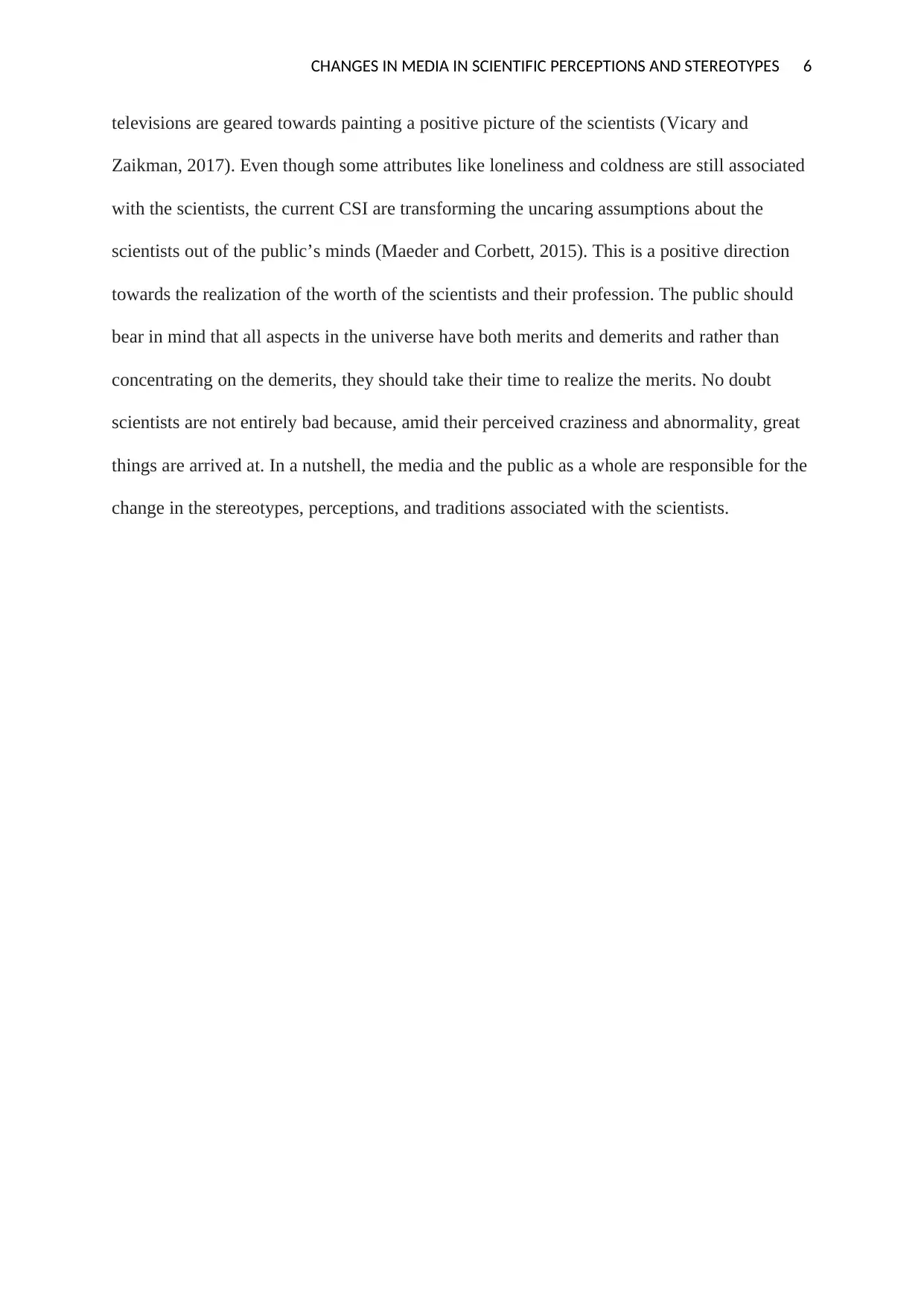
CHANGES IN MEDIA IN SCIENTIFIC PERCEPTIONS AND STEREOTYPES 6
televisions are geared towards painting a positive picture of the scientists (Vicary and
Zaikman, 2017). Even though some attributes like loneliness and coldness are still associated
with the scientists, the current CSI are transforming the uncaring assumptions about the
scientists out of the public’s minds (Maeder and Corbett, 2015). This is a positive direction
towards the realization of the worth of the scientists and their profession. The public should
bear in mind that all aspects in the universe have both merits and demerits and rather than
concentrating on the demerits, they should take their time to realize the merits. No doubt
scientists are not entirely bad because, amid their perceived craziness and abnormality, great
things are arrived at. In a nutshell, the media and the public as a whole are responsible for the
change in the stereotypes, perceptions, and traditions associated with the scientists.
televisions are geared towards painting a positive picture of the scientists (Vicary and
Zaikman, 2017). Even though some attributes like loneliness and coldness are still associated
with the scientists, the current CSI are transforming the uncaring assumptions about the
scientists out of the public’s minds (Maeder and Corbett, 2015). This is a positive direction
towards the realization of the worth of the scientists and their profession. The public should
bear in mind that all aspects in the universe have both merits and demerits and rather than
concentrating on the demerits, they should take their time to realize the merits. No doubt
scientists are not entirely bad because, amid their perceived craziness and abnormality, great
things are arrived at. In a nutshell, the media and the public as a whole are responsible for the
change in the stereotypes, perceptions, and traditions associated with the scientists.
⊘ This is a preview!⊘
Do you want full access?
Subscribe today to unlock all pages.

Trusted by 1+ million students worldwide
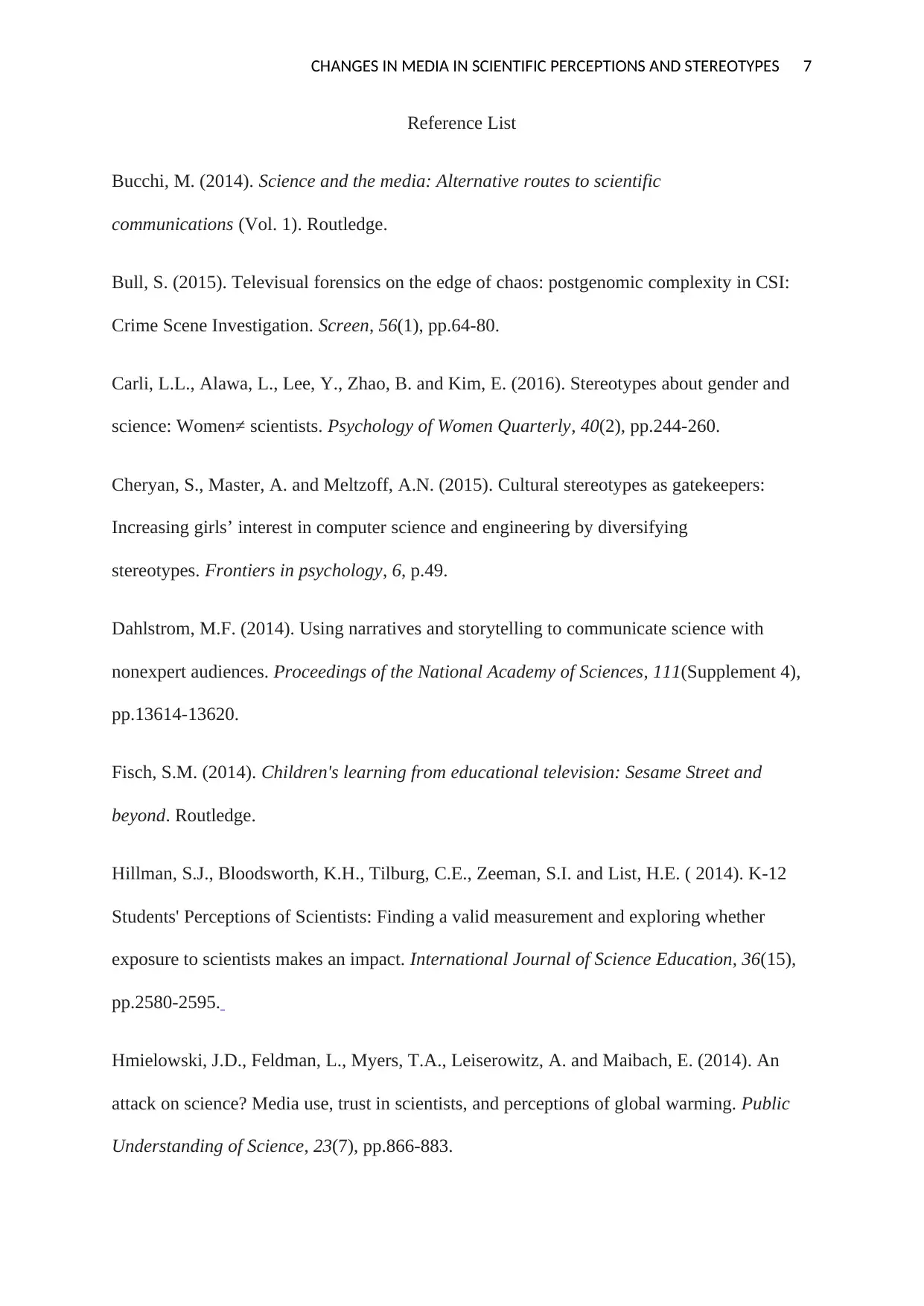
CHANGES IN MEDIA IN SCIENTIFIC PERCEPTIONS AND STEREOTYPES 7
Reference List
Bucchi, M. (2014). Science and the media: Alternative routes to scientific
communications (Vol. 1). Routledge.
Bull, S. (2015). Televisual forensics on the edge of chaos: postgenomic complexity in CSI:
Crime Scene Investigation. Screen, 56(1), pp.64-80.
Carli, L.L., Alawa, L., Lee, Y., Zhao, B. and Kim, E. (2016). Stereotypes about gender and
science: Women≠ scientists. Psychology of Women Quarterly, 40(2), pp.244-260.
Cheryan, S., Master, A. and Meltzoff, A.N. (2015). Cultural stereotypes as gatekeepers:
Increasing girls’ interest in computer science and engineering by diversifying
stereotypes. Frontiers in psychology, 6, p.49.
Dahlstrom, M.F. (2014). Using narratives and storytelling to communicate science with
nonexpert audiences. Proceedings of the National Academy of Sciences, 111(Supplement 4),
pp.13614-13620.
Fisch, S.M. (2014). Children's learning from educational television: Sesame Street and
beyond. Routledge.
Hillman, S.J., Bloodsworth, K.H., Tilburg, C.E., Zeeman, S.I. and List, H.E. ( 2014). K-12
Students' Perceptions of Scientists: Finding a valid measurement and exploring whether
exposure to scientists makes an impact. International Journal of Science Education, 36(15),
pp.2580-2595.
Hmielowski, J.D., Feldman, L., Myers, T.A., Leiserowitz, A. and Maibach, E. (2014). An
attack on science? Media use, trust in scientists, and perceptions of global warming. Public
Understanding of Science, 23(7), pp.866-883.
Reference List
Bucchi, M. (2014). Science and the media: Alternative routes to scientific
communications (Vol. 1). Routledge.
Bull, S. (2015). Televisual forensics on the edge of chaos: postgenomic complexity in CSI:
Crime Scene Investigation. Screen, 56(1), pp.64-80.
Carli, L.L., Alawa, L., Lee, Y., Zhao, B. and Kim, E. (2016). Stereotypes about gender and
science: Women≠ scientists. Psychology of Women Quarterly, 40(2), pp.244-260.
Cheryan, S., Master, A. and Meltzoff, A.N. (2015). Cultural stereotypes as gatekeepers:
Increasing girls’ interest in computer science and engineering by diversifying
stereotypes. Frontiers in psychology, 6, p.49.
Dahlstrom, M.F. (2014). Using narratives and storytelling to communicate science with
nonexpert audiences. Proceedings of the National Academy of Sciences, 111(Supplement 4),
pp.13614-13620.
Fisch, S.M. (2014). Children's learning from educational television: Sesame Street and
beyond. Routledge.
Hillman, S.J., Bloodsworth, K.H., Tilburg, C.E., Zeeman, S.I. and List, H.E. ( 2014). K-12
Students' Perceptions of Scientists: Finding a valid measurement and exploring whether
exposure to scientists makes an impact. International Journal of Science Education, 36(15),
pp.2580-2595.
Hmielowski, J.D., Feldman, L., Myers, T.A., Leiserowitz, A. and Maibach, E. (2014). An
attack on science? Media use, trust in scientists, and perceptions of global warming. Public
Understanding of Science, 23(7), pp.866-883.
Paraphrase This Document
Need a fresh take? Get an instant paraphrase of this document with our AI Paraphraser
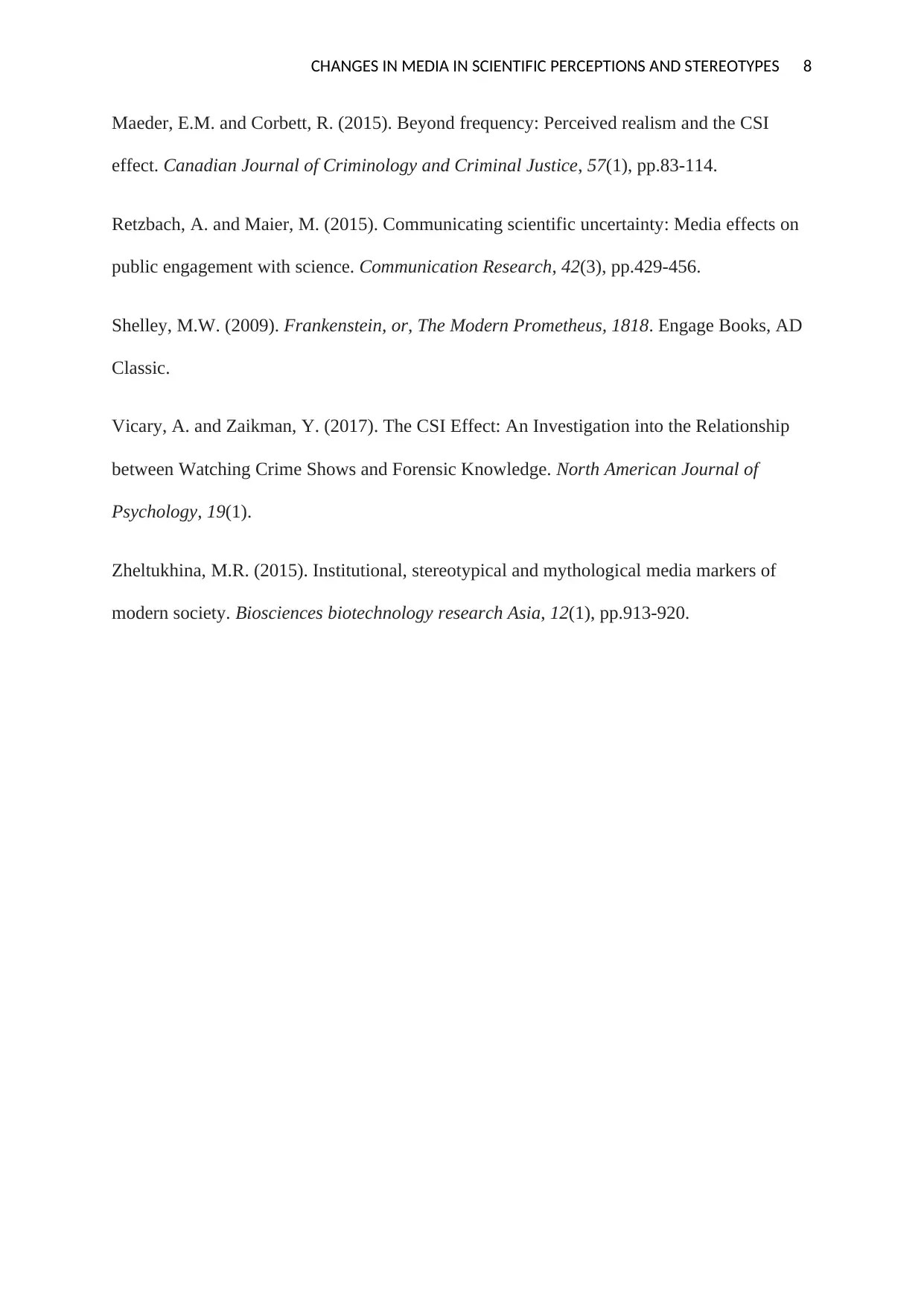
CHANGES IN MEDIA IN SCIENTIFIC PERCEPTIONS AND STEREOTYPES 8
Maeder, E.M. and Corbett, R. (2015). Beyond frequency: Perceived realism and the CSI
effect. Canadian Journal of Criminology and Criminal Justice, 57(1), pp.83-114.
Retzbach, A. and Maier, M. (2015). Communicating scientific uncertainty: Media effects on
public engagement with science. Communication Research, 42(3), pp.429-456.
Shelley, M.W. (2009). Frankenstein, or, The Modern Prometheus, 1818. Engage Books, AD
Classic.
Vicary, A. and Zaikman, Y. (2017). The CSI Effect: An Investigation into the Relationship
between Watching Crime Shows and Forensic Knowledge. North American Journal of
Psychology, 19(1).
Zheltukhina, M.R. (2015). Institutional, stereotypical and mythological media markers of
modern society. Biosciences biotechnology research Asia, 12(1), pp.913-920.
Maeder, E.M. and Corbett, R. (2015). Beyond frequency: Perceived realism and the CSI
effect. Canadian Journal of Criminology and Criminal Justice, 57(1), pp.83-114.
Retzbach, A. and Maier, M. (2015). Communicating scientific uncertainty: Media effects on
public engagement with science. Communication Research, 42(3), pp.429-456.
Shelley, M.W. (2009). Frankenstein, or, The Modern Prometheus, 1818. Engage Books, AD
Classic.
Vicary, A. and Zaikman, Y. (2017). The CSI Effect: An Investigation into the Relationship
between Watching Crime Shows and Forensic Knowledge. North American Journal of
Psychology, 19(1).
Zheltukhina, M.R. (2015). Institutional, stereotypical and mythological media markers of
modern society. Biosciences biotechnology research Asia, 12(1), pp.913-920.
1 out of 8
Your All-in-One AI-Powered Toolkit for Academic Success.
+13062052269
info@desklib.com
Available 24*7 on WhatsApp / Email
![[object Object]](/_next/static/media/star-bottom.7253800d.svg)
Unlock your academic potential
Copyright © 2020–2025 A2Z Services. All Rights Reserved. Developed and managed by ZUCOL.

